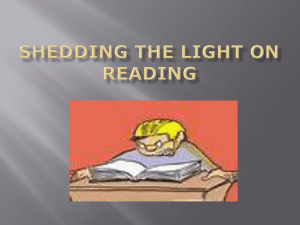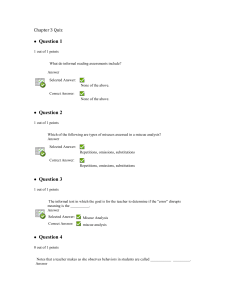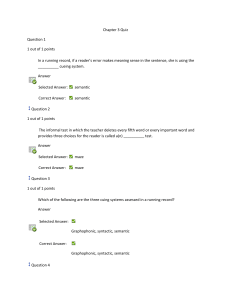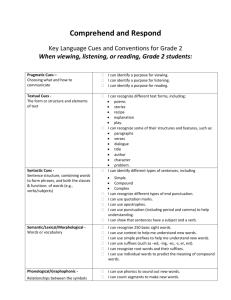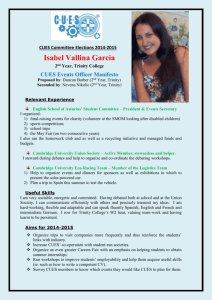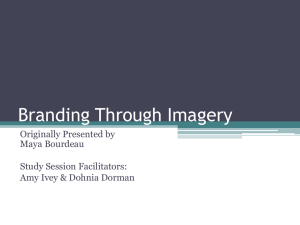The Reading Process
advertisement
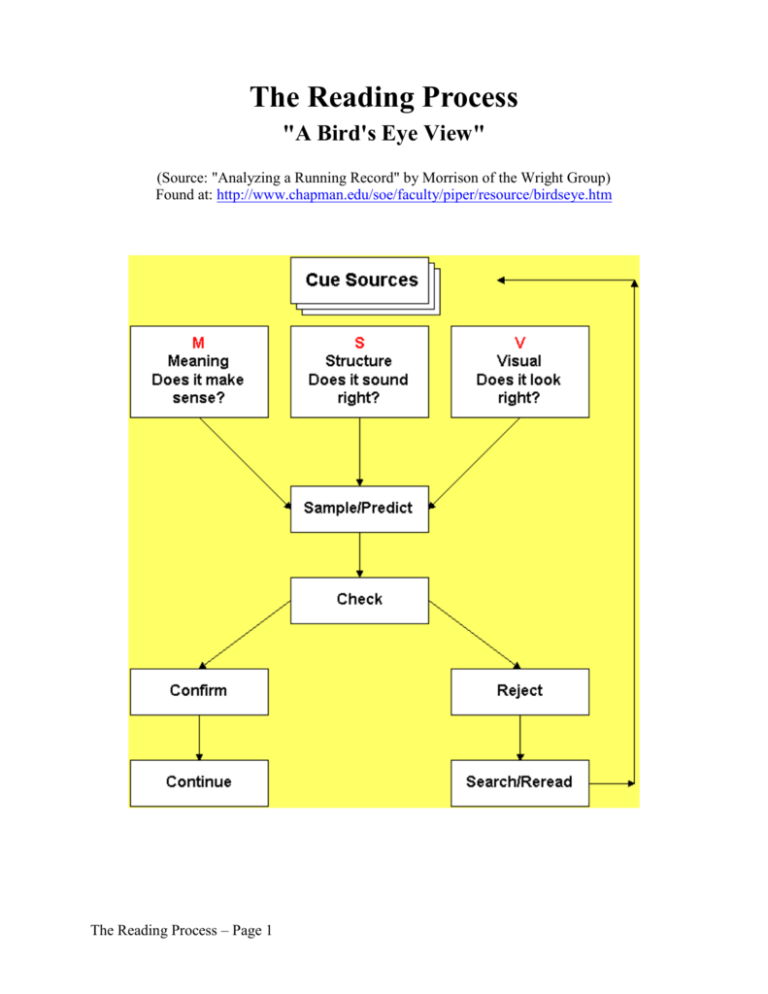
The Reading Process "A Bird's Eye View" (Source: "Analyzing a Running Record" by Morrison of the Wright Group) Found at: http://www.chapman.edu/soe/faculty/piper/resource/birdseye.htm The Reading Process – Page 1 Reading and Viewing Cueing Systems The use of pragmatic cues refers to readers' understanding of how text structure works and their purpose for reading. Syntactic cues refer to the structure of language or how language works. Semantic cues refer to the meaning that has become associated with language through prior knowledge and experience. Graphophonic cues refer to knowledge about the sound-symbol system and how readers apply this knowledge as they read. Source: Adapted from "The Official Website of the Government of Prince Edward Island" at http://www2.gov.pe.ca/educ/publications/apef/ela/entry-3/reading_viewing_cueing.asp The Reading Process – Page 2 Pragmatic Cueing System The use of pragmatic cues refers to readers' understanding of how text structure works and their purpose for reading. Readers use this information to predict meaning as they read. Understanding the basic structure of a narrative, as well as the features of a story particular to various genres (fairy tales, mysteries, etc.) allows children to set the appropriate purpose for reading and to predict more successfully. Children learn to recognize the text structure cues related to expository text, such as headings, illustrations, graphs, or bolded words. This allows them to activate prior knowledge and support prediction as they read. Effective readers have a wide background of experience with language in many situations, although experience will vary in different cultural contexts. To expand students' knowledge of written language in its various uses, the teacher may immerse students in a variety of genres and styles of literature read a wide variety of non-fiction to students discuss the information readers receive from non-print cues such as illustrations, story pattern and structure use a variety of text structures and story mapping techniques with students, helping them to recognize and chart the text structure visually Semantic Cueing System Semantic cues refer to the meaning that has become associated with language through prior knowledge and experience. Semantic context consists of meaningful relations among words and ideas. Readers/viewers construct meaning when they relate the information in the text to what they know. When they use their background knowledge, meaning contained in illustrations, and meaning contained in the words and their relationships, they are making use of semantic cues. The key question readers/viewers ask when they are making use of semantic cues is, What would make sense? Self-correction when the text does not make sense is an indication of the child's level of appreciation for and effective use of meaning cues. Effective readers have extensive knowledge of a wide range of topics and related language. To build students' experiential and language base, and to encourage reading for meaning, the teacher may extend students' background experiences and involve them in as many real-life experiences as possible discuss experiences to extend students' understanding and related vocabulary encourage extensive independent reading, to help build students' experiences with a range of topics before reading, have students recall and share what they know about the topic to build their knowledge of the concepts and knowledge in the text encourage predictions before and during reading to encourage reading for meaning; explain to students why they are making predictions before they read and how to use this prior knowledge effectively as a reading strategy help students clarify and extend understanding by having them respond to reading in a variety of ways, such as through drama, writing, discussion, and drawing help students learn to use the semantic cueing system by teaching them to ask themselves as they read, What would make sense here? Did that make sense? use oral and written cloze activities, focusing on meaning to predict and confirm The Reading Process – Page 3 Syntactic Cueing System Syntactic cues refer to the structure of language or how language works. Readers who use information such as sentence structure, word order, function words, and word endings as they read are making use of syntactic cues. Self-correction of miscues that do not sound right (in terms of normal English sentence structure) provides evidence of the students' appreciation for and use of syntactic cues. It should be recognized, however, that ESL* students will bring a different experience and understanding to the phrase sounds right. To build students' knowledge of how language works, the teacher may read to students from a wide variety of literature provide time and opportunity for students to read independently provide literature with repeated syntactic and semantic patterns, thus encouraging students to make predictions based on their know ledge of such patterns provide opportunities for students to use language for different purposes—to tell stories, to explain, to ask questions, to give directions use oral and written cloze activities, focussing on syntactic patterns to predict and confirm/self-correct demonstrate through oral reading how to use syntactic cues to predict and recognize miscues (Model self-correcting because of these miscues. Have students listen for parts of the passage that don't sound right so that they can develop an awareness of what the term actually means.) encourage students to use the read ahead strategy and explain that this often helps them to predict a difficult word based on the structure of the rest of the sentence * ESL includes new immigrants and students whose first language is not English. Graphophonic Cueing System Graphophonic cues refer to knowledge about the sound-symbol system and how readers apply this knowledge as they read. This includes knowledge about directionality and spacing as students develop the concept of word and learn to track print. Effective readers develop generalizations about letter-sound relationships and integrate this knowledge with their use of the semantic and syntactic cueing systems. Phonological Awareness Phonological awareness is an understanding of the sound structure of language, which develops initially in oral language. Students with well-developed phonological awareness are then able to map their developing knowledge of sound and letter correspondence onto an underlying understanding of how language can be segmented and blended into its component parts. This would include an understanding of words, syllables, rhymes, and finally, individual sounds. For example, the tasks of judging whether two words rhyme or begin with the same sound, or clapping out the sounds in a word require phonological awareness. Recent research suggests there are different levels of phonological awareness. For example, being able to detect rhyme or hearing the syllables in words is easier than being able to hear and manipulate the individual phonemes (e.g., hearing that the word seek contains three phonemes /s/ /e/ /k/). There is a growing body of evidence suggesting a strong connection between students' phonological awareness and their reading development. Research shows that being able to segment and blend language is an essential skill if students are to be able to use graphophonic cues effectively in reading. Many children enter school with some phonological awareness. If they have had lots of experience with oral language, they are often able to detect words that The Reading Process – Page 4 rhyme or words that start with the same sound. Phonological awareness continues to develop as children learn to read. Their attempts at temporary spelling also support the development of phonological awareness as they segment the words they want to spell. Teachers can help students build upon the phonological awareness they have when they enter school in several ways: providing many opportunities for students to play with words in oral language to support the development of phonological awareness providing extensive experiences with rhyme in contexts such as shared language, readaloud, and rhyming games so that students can develop the ability to recognize and generate rhymes automatically clapping the syllables in a word (e.g., singing : / / - sing ing); listening for the secret word (saying the word syllable by syllable and having students guess the word) helping students learn to segment rhyming words at the rime/onset boundary (m-an) orally. This becomes an important strategy in reading and spelling as children look for familiar word chunks, rather than having to segment and blend each word sound by sound using picture sorts to help students compare and contrast features of words clapping the individual phonemes in a word, e.g., at : / / team: / / (For students who find this a difficult task, the Reading Recovery strategy of using Elkonin boxes can be helpful; that is using squares and counters for each phoneme, and having the child push the counters into the boxes as he/she says each phoneme) Developing Graphophonic Knowledge Students build upon their phonological awareness in oral language as they learn to use their developing knowledge of how letters/sounds work. They make the connection to how sounds and letters work in print through their attempts to make meaning in what they are reading and as they explore sounds through temporary spelling in the writing process. To support the development of the graphophonic cueing system, students need to learn about the alphabet and the sounds the letters make. Sound awareness activities focussing on rhyme and alliteration support the development of this knowledge. Teachers need to recognize that some students will have difficulty in learning about the graphophonic system because of difficulties with phonological awareness and the range of development common to early primary classrooms. Some students may need more time and more explicit practice to learn about letters and sounds, as well as to learn how to use graphophonic cues as they read and write. As with any strategy, teachers need to be modeling how and when to use this knowledge in the reading process. Two excellent opportunities for such modeling are through the use of the morning message and individual conferences with students. To help students build graphophonic knowledge and learn to use it in an integrated way with the other cueing systems, the teacher may introduce a sound-symbol relationship to children in context—following is a suggestion of one way to do this: Read a poem, rhyme, or book to students. A first reading should focus on meaning and enjoyment, before exploring a particular sound in a sentence or part (e.g., "There's a hole in my beach ball, and a hole in my kite. There's a hole in my teddy where Scruffy took a bite. There's a hole in my school bag and a hole in my glove." from Oh No !) Without showing students the print, ask them what sound they hear at the beginning of beach, ball, bite and bag. The Reading Process – Page 5 Have students say the sound, focussing on the shape of their mouths as they produce the sound. Have students brainstorm words they know that start with/contain the sound. Start making a list that students can add to as they find more words. Help students make the connection between the sound and the letter that makes it by telling them that the sound /b/ is made with the letter "b." Show students how to make the letter and have them make it in a variety of ways, e.g., in the air, on the palm of the hand with a finger, on the board with chalk. Return to the context of the book and read it again, this time drawing students' attention to the sound in print. Help students learn to use this phonics knowledge, along with other cues, in the reading of other Big Books, poems, and rhymes in shared reading, guided reading, and reading conferences. Through shared writing, writing conferences, and minilessons, show students how to use this knowledge in trying to spell a word. help students develop an understanding of letter-sound relationships by providing opportunities for them to hear language and then see it in print see their own words and sentences in print hear language while following it in print build a sight vocabulary of signs, letters, labels, and other print in their environment draw attention to phonics relationships in the context of reading and when modeling writing use shared reading experiences, such as big books, poems, songs and chants on charts, morning messages, pointing to the words to reinforce directionality and to focus on particular letter-sound relationships provide many opportunities for writing, encouraging students to use temporary spelling until they know the conventional spelling (This exploration of sound through temporary spelling is an integral part of the students' development of graphophonic knowledge.) read alphabet books to students providing opportunities for reading and writing alphabet books encourage students to develop personal word lists, such as word families and words that sound the same have a variety of dictionaries available use oral and written cloze activities, focussing on graphic cues along with semantic and syntactic cues to predict and confirm make sentence strips taken from familiar books or poems and cut the sentences into phrases/words (The activity of unscrambling the words to make meaningful sentences focuses attention on the print.) use picture and word sorts to help students compare and contrast features of words help emergent readers develop the early strategies of directionality and one-to- one matching (Using a pointer during shared reading and encouraging emergent readers to read with their fingers help them develop these strategies. Students can be helped to monitor their reading for one-to-one matching with feedback such as, Did that match? or What did you notice?) The Reading Process – Page 6

